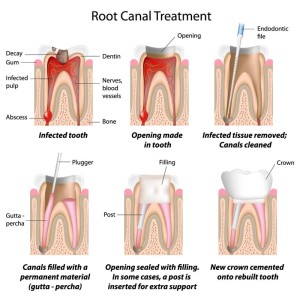Restorative Dentistry
At Bright Smiles Dental we take our patients oral health very seriously. We perform a variety of procedures designed to restore teeth and their supporting structures to the function and appearance that our patients deserve.
Dentures
There are many different types of dentures; no matter the differences their purpose is to replace missing teeth. Dentures may restore a patient’s ability to eat, speak and smile. When all of the teeth are missing a full denture is required. Full dentures retention can be greatly aided by the addition of implants. Again there exist many methods of attaching the denture to the implants; however, they all greatly aid in the dentures retention and patient comfort and confidence. A partial denture simply replaces missing teeth when patients have some or most of their healthy natural teeth. A partial denture can greatly increase a patient’s smile and confidence. They also help to prevent the remaining teeth from shifting and becoming crooked.
Porcelain Crowns and Fixed Bridges
Dental crowns are designed to closely replicate the look and feel of natural teeth. When most of the original tooth has been destroyed by tooth decay or trauma a crown may be recommended to re-establish its original function and appearance.
When a single tooth is missing treatment options include a bridge or an implant. A dental bridge replaces the missing tooth by spanning the space. The teeth on either side of the missing tooth must be prepared for a crown in much the same way that a single crown would be performed. Then a bridge is fabricated to include the adjacent teeth in addition to the missing teeth and then we cement them as one unit.
Tooth-Colored Dental Fillings
The tooth-colored fillings are called composite fillings. At Bright Smiles we do not perform any amalgam fillings (the silver fillings). Some of the greatest advancements in recent dentistry have been centered on bonded restoration. Composite fillings have a great advantage over silver fillings in that they bond chemically to the natural tooth structure, requiring less tooth destruction. Further they harden in seconds unlike the other materials. If damaged the composite fillings can be repaired without complete removal of the old filling.
Root Canal Therapy
If a tooth nerve is diseased for whatever reason, i.e. large caries extending to the nerve or trauma, a root canal must be completed. This means the nerve must be removed and the inside of the tooth cleaned and sealed. Inside each tooth is the pulp, it consist of the blood vessels, lymphatics, connective tissue as well as the nerve. Bacteria and other byproducts can cause an infection in the bone surrounding the tooth. When this infection occurs it can be very painful; however this is not always the case as some pulp can die with little to no discomfort. In either case it becomes necessary to remove as much of the infected/dead pulp as possible so that the bacteria cannot survive and grow to such levels to cause an infection. After the tooth is cleaned inside it will be sealed with a permanent material called gutta-percha. A quality restoration must be placed on the tooth to complete the seal which in most cases is a dental crown.

